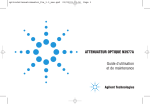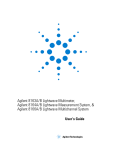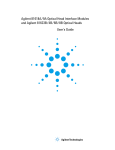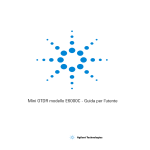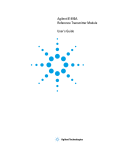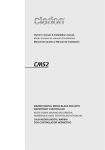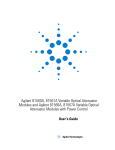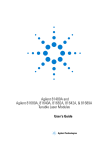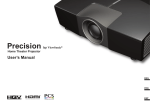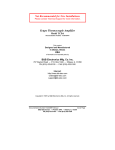Download Agilent Technologies N3970A Specifications
Transcript
N3970A OPTICAL POWER METER Operating and Maintenance Guide ■ N3970A OPTICAL POWER METER SOURCE QUICK REFERENCE GUIDE ■ To remove interchangeable connector, move interface to mid position, and pull off adaptor. ■ To defeat auto power-off, hold POWER for 3 seconds at turn on until ON and perm are displayed. ■ To access hidden keypad, pull up display cover. Select POWER, Source, then: ■ To set reference, push Abs/Rel and hold Set Ref for 3 seconds (3 buzzer sounds). ■ To display reference, hold Abs/Rel, so Ref flashes. ■ To stop / start display update, push Hold. ■ If a test tone is detected, meter will display Hz. AUTOTEST OPERATION ■ No user action is required for meter to enter Autotest mode. ■ Autotest: Push Autotest on source and wait a few seconds. ■ Can also push Autotest on meter for faster lock-on. ■ To display one wavelength only, on the power meter push the left side of -/+ and again for the other wavelength. Push right side of -/+ (twice) to exit. ■ Autotest remains for >8 seconds after signal loss, to allow quick connection change. ■ To exit autotest, remove test lead or turn off source for >8 seconds. MANUAL OPERATION ■ To turn on and select wavelength, push: POWER, Power Meter, -/+. ■ To display linear mode, push dBm/W. ■ To display max/min values, push MAX/MIN repeatedly. Hold MAX/MIN to reset (3 buzzer sounds). . MEMORY ■ Enter Power Meter or Autotest modes first ■ While in Autotest mode, it is only possible to STORE. ■ To clear all memory, push both RECALL and CANCEL together for 3 seconds. clr will display. ■ To store in next location, push STORE. ■ To change next store location, push SELECT -/+, SET. ■ To recall, push RECALL -/+ to scroll through data. ■ To exit memory display, push CANCEL. ADDITIONAL AUTOTEST MEMORY OPERATION ■ To read or cancel memory, first exit Autotest mode, and enter Power Meter mode. ■ Autotest memory: use -/+ to scroll wavelengths. ■ INTRODUCTION AND APPLICATIONS N3970A OPTICAL POWER METER Congratulations on your purchase of this instrument, which has been engineered to provide the best possible reliability, convenience and performance. To get the best use from your equipment and ensure its safe operation, please spend a few minutes to read this manual. 1 ■ CONTENTS 3 Care of your instrument 19 Introduction & applications Service and Support 4-5 Accuracy considerations 20-21 Safety Summary 6-7 Calibration, maintenance & instrument returns 22-24 Battery and external power Optical connector 8 9-10 How to use: Specifications - Definition of terms 25 Specifications and ordering information 26-28 Performance test 29-38 Getting started and turning on 11-12 Cleaning information 39-40 Autotest operation 13-14 Cleaning procedures 41 Power meter operation Storing & recalling readings RS232 interface 15 16-17 Disclaimer & warranty Notes 42 43-44 18 BEFORE READING FURTHER, OPEN THE CONTROL PANEL PICTURE AT THE BACK OF THE MANUAL 2 ■ SERVICE AND SUPPORT Any adjustment, maintenance, or repair of this product must be performed by qualified personnel. Contact your customer engineer through your local Agilent Technologies Service Center. You can find a list of local service representatives on the Web at: http://www.agilent.com/find/assist If you do not have access to the Internet, one of these centers can direct you to your nearest representative: United States Canada Europe Japan Latin America Australia New Zealand Asia-Pacific 1 800 629 485 (613) 9272 0749 (Fax) 0800 738 378 64 4 495 8950 (Fax) (852) 3197 7777 (852) 2506 9284 (Fax) 1 800 452 4844 1 877 894 4414 (905) 206 4120 (Fax) (31 20) 547 2323 (31 20) 547 2390 (Fax) (81) 426 56 7832 (81) 426 56 7840 (Fax) (305) 269 7500 (305) 269 7599 (Fax) N3970A UM-1 3 ■ INTRODUCTION AND APPLICATIONS The N3970A Optical Power Meter is used for field or laboratory testing of fiber optic systems at typically 850, 1300, 1310 and 1550 nm. It features superb measurement confidence, ease of use and reduced cost of ownership, and is for use by installers, technicians and engineers. Superior measurement confidence is achieved with a unique Total Uncertainty specification over the full temperature, measurement and connector range, and a NATA traceable calibration certificate. The display hold and back light facilities help acquire readings, and the flexible memory helps record your results Autotest mode enables automatic λ (wavelength) detection and attenuation measurement (in combination with an Autotest source). A single or dual λ source and meter in Autotest mode automatically measure single or dual λ attenuation in one direction. 4 High operational reliability & availability is achieved with 250 hour battery life, 3 year recommended re-calibration cycle, negligible warm up and no range-changing delays. Dark current offset is not required. An external power input is also provided. The combination of features enables reduced equipment inventory, simpler training, shorter procedures, lower skill levels and direct labour savings in many situations, combining to give lower cost of ownership. The innovative optical connector port provides drop protection during use, and is dust protected by a snap on cover. The interchangeable optical connector system is very versatile, and easily disassembled for cleaning. The simple user interface guides the operator through functional sequences, and a hidden keypad is used to access advanced features such as log/linear display, and memory functions. ■ INTRODUCTION AND APPLICATIONS The tone detector is very sensitive, and is useful for fiber identification, and calibrating the modulation frequency of test tone sources. The instrument has shock absorbent corners, and a tough polycarbonate housing which has passed extensive drop testing. Typical applications ■ Singlemode testing, with versatile interchangeable connectors. ■ Telecom construction, maintenance, CATV, LAN and R&D applications. ■ Measurements where traceability and documentation are required. ■ Quality assurance and acceptance tests. ■ Automated testing and reporting using optional Excel software. ■ Test tone measurement & fiber identification. N3970A UM-1 5 ■ SAFETY SUMMARY The following general safety precautions must be observed during all phases of operation, service, and repair of this instrument. Failure to comply with these precautions or with specific warnings elsewhere in this manual violates safety standards of design, manufacture, and intended use of the instrument. Agilent Technologies Inc. assumes no liability for the customer’s failure to comply with these requirements. Before operation, review the instrument and manual, for safety markings and instructions. You must follow these to ensure safe operation and to maintain the instrument in safe condition. WARNING The WARNING sign denotes a hazard. It calls attention to a procedure, practice or the like, which, if not correctly performed or adhered to, could result in injury or loss of life. Do not proceed beyond a WARNING sign until the indicated conditions are fully understood and met. 6 CAUTION The CAUTION sign denotes a hazard. It calls attention to an operating procedure, or the like, which, if not correctly performed or adhered to, could result in damage to or destruction of part or all of the product. Do not proceed beyond a CAUTION sign until the indicated conditions are fully understood and met. CAUTION m The apparatus will be marked with this symbol when it is necessary for the user to refer to the instruction manual in order to protect the apparatus against damage. ■ SAFETY SUMMARY Initial Inspection Line Power Requirements Inspect the shipping container for damage. If there is damage to the container or Cushioning, keep them until you have checked the contents of the shipment for completeness and verified the instrument both mechanically and electrically. The Performance Tests give procedures for checking the operation of the instrument. If the contents are incomplete, mechanical damage or defect is apparent, or if an instrument does not pass the operator’s checks, notify the nearest Agilent Technologies Sales/Service Office (see page 3). The Agilent N3970A Power Meter operates at line power when applied to the optional external power supply N3979A 9V DC WARNING To avoid any hazard, do not perform electrical tests when there are signs of shipping damage to any portion of the outer enclosure (covers, panels, and so on). Operating Environment The Agilent N3970A Power Meter can be operated at temperatures between - 10°C and + 55°C and at relative humidity of <95%. Storage and Shipment The Agilent N3970A Power Meter can be stored or shipped at temperatures between - 25°C and + 70°C and at relative humidity of less than 95%. Protect the module from temperature extremes that may cause condensation within it. REQUIREMENT COMPLIANCE WARNING You MUST return instruments with malfunctions to an Agilent Technologies Service Center for repair and calibration (see page 3). N 10149 N3970A UM-1 7 ■ BATTERY AND EXTERNAL POWER The instrument is powered by two 1.5V dry batteries (Alkaline C) for an operating period of typically 250 hours or two 1.2V rechargeable batteries for an operating period of approximately 125 hours. Do not use lithium batteries or other batteries with a nominal voltage greater than 1.8 V. The instrument will be damaged. When the batteries are low, the low-battery indicator is shown on the display. At this stage, there is approximately enough energy for another 30 minutes of use. For saving of energy the instrument automatically turns off after 10 minutes without operation. For changing the battery, open the cover of the battery compartment at the base of the instrument, remove the batteries, insert new batteries (check polarity) and close the cover again. Rechargeable batteries must be charged by an external charger. 8 For operation of the instrument by external power use Agilent AC adaptor N3979A (9V DC, 1.33 A, ). Use of the external power supply disconnects the batteries. Ensure that the mains supply has the correct voltage rating and safety compliance as relevant. Do not use non-compliant or doubtful mains equipment. ■ OPTICAL CONNECTOR The optical port is mounted on a swivel, which allows the connector to be angled outwards for accessibility, and then pushed back and covered with the snap cover to provide dirt and drop protection. The other port can be used to store a spare interchangeable optical connector. To install the connector adaptor, align the locating slot on the side of the adaptor with that on the instrument connector, and push it on. To remove the connector adaptor, move the connector port to it’s mid-way point (see dotted line on diagram at back of manual), and then pull off the adaptor. It is not possible to remove the adaptor in the ‘open’ or ‘shut’ positions. With some styles of connector, it is easier to pull off the adaptor with a test lead in place, since this gives better grip. Different styles of connector adaptor ( ST, SC, FC, ) can be easily fitted by the user. Optical connectors are precision components, and require care in use: ■ Always clean the mating connector tip and ferrule before mating, using approved materials. ■ This instrument can be used with both PC and APC connector styles (unlike sources, which are factory configured for PC only ). ■ The soft carry case enables the instrument to be stored without removing the test leads. This practice saves time, and is to be recommended. ■ When not in use, keep all test ports and connectors covered and away from dust. ■ Do not touch connector tips with your fingers, since body oils and dirt can impair connector performance. ■ Do not use damaged or incompatible connectors. N3970A UM-1 9 ■ OPTICAL CONNECTOR Cleaning The glass power meter interface does not make contact with the inserted connector: there is a slight air gap. Therefore it should not wear out, and only needs occasional cleaning. To clean the glass power meter interface: remove the interchangeable adaptor to access the glass interface, then use a sticky material such as ‘ Blu tac ‘ to dab the glass and remove any dirt. A soft brush, alcohol, or air can are also appropriate. Do not use anything hard that could scratch the glass. In this manual, refer to the sections on Cleaning Information and Procedures for further information. Bare fiber adaptors Bare fiber adaptors used with this power meter must achieve fiber eccentricity of +_ 100 microns and end tolerance of _+ 0.3 mm, relative to the ferrule end. Be careful not to scratch the detector interface when using adaptors, since permanent 10 meter inaccuracy may result. Preferred bare fiber adaptors consist of a connector with fiber retention device. If you work regularly with bare fibers, to avoid potential damage to the meter, it is generally preferable to use an alternative arrangement such as a multimode pigtail with a v-groove or mechanical splice. ■ GETTING STARTED AND TURNING ON This and following sections show you how to use your instrument: This instrument uses a menu driven keypad. The function of each button is shown on the display. Check that the correct accessories have been supplied, and an optical connector adaptor has been fitted. If you have any queries, call your supplier to resolve the situation. To access the optical connector, grasp a top corner of the instrument, and pull off the cover. The connector can be swivelled to improve access. Put in the batteries, or plug external power into the socket at the top of the instrument (see Battery and External Power section). After instrument turn on, the instrument will perform a selfcalibration sequence, set the dark current adjustment, and then display absolute power in dBm at the previously set λ. If HI or LO are displayed, the input is out of range. The hidden keypad is accessed by pulling up the hinged display cover. The hidden keypad can operate in two modes. The second mode is accessed by SHIFT. Access to the second mode can be denied / permitted by typing the button sequence : POWER (turn on instrument), SHIFT, CANCEL, SET, SELECT, RECALL, STORE. Push the green POWER button. The display will come on. If the battery is low, this will be indicated on the display. Pushing POWER again will turn the instrument off. To stop the instrument turning off 10 minutes after the last key press, hold POWER down for 3 seconds during turn-on. PERM on the display indicates that the unit will stay on permanently. To back light the display temporarily, select LIGHT. To back light continuously, hold down the button for 3 seconds. Use of the back light will drain the batteries faster. N3970A UM-1 11 ■ GETTING STARTED AND TURNING ON To disable or enable the buzzer, hold down SHIFT for 3 seconds. To add the carry strap: slip the end of the strap through the slit on the curved section at the back of the instrument, and secure the buckle. This instrument requires no warm up, and no user adjustment of dark current to achieve it’s specified performance. To learn how to use the instrument features, go to the next section. Should the instrument fail to turn on, the microprocessor may need re-booting. To do this, remove batteries and external power for at least 40 seconds. This will not lose stored data. 12 ■ AUTOTEST OPERATION General Autotest features Operation For Autotest to function, all instruments involved in the test must be Agilent Handheld instruments with an Autotest function. Turn on the source and meter, and connect them with a test lead. On the light source, push AUTOTEST. This is all that is required to start Autotest operation on the power meter. The meter will automatically set to the correct λ and display absolute power in dBm. The display will alternate between wavelengths. To display only one λ at a time, push +/-. The Autotest feature performs automated measurement (and automatic λ detection) by data exchange between instruments, and requires minimal operator knowledge: turn the instrument on, connect a test lead, and select AUTOTEST on the source. Subsequent operation is automated, although some choices can be made for convenience. Functionality is determined by the options fitted to the instrument(s) used. Autotest configures itself according to the options available, and carries out the most comprehensive test possible. Autotest remains synchronised for about 8 seconds, which enables the user to change optical connections without re-starting Autotest each time. A light source transmits Autotest signals at one or two wavelengths to an appropriate power meter. You may also select AUTOTEST on the meter, which forces the meter into Autotest mode, with faster synchronisation in this mode (the source must be in Autotest mode). Push MENU to exit. The source power transmitted from the source is displayed on the left hand side of the display. Push ABS/REL to make the meter display relative power. The stored reference value(s) are displayed on the left hand side of the display. To take a reference under Autotest, connect the source and N3970A UM-1 13 ■ AUTOTEST OPERATION meter with a test lead. Set the source to Autotest mode, and then push SET REF on the meter for 3 seconds. This will store the reference at all relevant wavelengths. Either a ‘local’ or ‘remote’ reference can be stored. To exit Autotest mode, either disconnect the optical test lead, or exit Autotest mode on the light source for > 8 seconds. Refer also to manual sections on: ■ Storing and recalling readings. 14 ■ POWER METER OPERATION After instrument turn on, the meter will be calibrated at the last used λ. To change parameters, push POWER METER, then: To select a calibrated λ, push +/-. λ is displayed on the top right side of the display. To display relative power, push ABS/REL. The display will show dB R. To store a new reference, push SET REFfor 3 seconds. To display the stored reference value, keep ABS/REL depressed. To change the dBm display between linear and log, access the hidden keypad and push dBm/W. If the meter detects a modulated signal, the display will change to show the actual measured modulation frequency in Hz, and if a standard tone is detected ( eg 270 Hz, 1 KHz, 2 KHz ), a buzzer will sound. This is useful for fiber identification and signalling. The meter can also be used to check the actual modulation frequency of test sources. N3970A UM-1 15 ■ STORING & RECALLING READINGS There are various ways of storing and recording data, giving the user flexible ways of working. They are summarised here for your convenience. Storage of reference values: A separate reference is stored for each λ and can be recalled when the instrument is next turned on. Display hold: To hold the display at it’s current value, push HOLD. This value can then be stored. Push HOLD again to continue updating the display. Automatic recording of maximum & minimum limits: To display the minimum and maximum value over a period, access the hidden keypad and push MAX/MIN. The display will show the maximum and minimum values in sequence. Then push MAX/MIN for 3 seconds to re-start the recording process. This function re-sets automatically when instrument parameters are altered. 16 Storing & recalling readings using non-volatile memory In Autotest, stored data includes absolute & relative values at all possible wavelengths. Note: To recall data, the unit must be in manual ‘power meter’ mode. In manual mode, stored data includes absolute, relative and reference values. You can store, display or download up to 845 readings in nonvolatile memory. Memory No 1 - 199 200 - 1990 (steps of 10) 1 - 199 200 - 1990 (steps of 10) 1 - 199 Total memory Identifier mem mem ID ID mem / ID Space 199 179 199 179 89 845 ■ STORING & R ECALLING READINGS The memory location is shown at the top right of the display. When storing data, the memory automatically increments to facilitate the collection of data on a job. You can also go back and over-write particular records. After the data has been recorded, the entire memory can be cleared ready for the next job. Read from any location: push RECALL, +/-. To display the relative value, push ABS/REL, and to display the reference, hold down ABS/REL. Clear the whole memory: push CANCEL and RECALL together for 2 seconds. CLR will display. Memory operating sequence Store data in next location: push STORE Store data starting at a particular location: push SELECT, +/-, SET, STORE The memory can not be read in Autotest mode. Exit Autotest before reading the memory. N3970A UM-1 17 ■ RS232 INTERFACE The connection details of the instrument, and connecting cables are as follows : Some (out of spec) serial ports need a 10 K resistor in the D connector across wires 1 & 2. Instrument Jack Plug 9 Pin D connector for RS232 Wire 1 (screen) Body (Gnd) Pin 5 (Gnd) Wire 2 Ring (Tx) Pin 2 (Rx) Wire 3 Tip (Rx) Pin 3 (Tx) The RS232 interface can be used to access and control the instrument from an external computer. All functions can be accessed remotely. See next pages for available software. The baud rate can be set to: 0.3, 0.6, 1.2, 2.4, 4.8, 9.6, 19.2, 38.4, 56 Kbaud. The default and printer baud rate is 9.6 Kbaud. To set the baud rate, on the hidden keypad, select -SHIFT- BAUD RATE, then -/+ to SET the rate, followed by set. At turn on, the default is restored. Local / remote modes The hidden keypad enables the user to lock out the front panel controls, by selecting LOCAL or REMOTE. 18 ■ CARE OF YOUR INSTRUMENT ■ Follow the directions in this manual on cleaning optical connectors. ■ Limit the input optical power to no more than 5 dB overrange. ■ During storage and transport, keep the instrument in its carry case to protect against crushing, vibration, dust and moisture. ■ Clean the instrument using alcohol or other non solvent cleaning agents. Acetone or other active solvents may damage the case. ■ The instrument housing is made of tough Polycarbonate material with impact absorbing rubberised corner features, and is therefore drop resistant. ■ The instrument is resistant to normal dust and moisture, however it is not waterproof. If moisture does get into the instrument, dry it out carefully before using it again. ■ Where possible, keep instrument away from strong sunlight. ■ During prolonged storage, remove batteries to eliminate the possibility of acid leakage. Use only high quality sealed alkaline batteries. N3970A UM-1 19 ■ ACCURACY CONSIDERATIONS All measurements Optical connectors should be kept clean and in good condition. Due to emitter center λ uncertainty (eg 1310 +/- 20 nm), fiber attenuation may vary with different sources. This λ uncertainty can also affect power meter calibration. This is significant with InGaAs in the 850 nm band, and absolute errors in the order of 1 dB are possible. This issue affects absolute power measurements. It does not significantly affect attenuation measurements where the meter was referenced to the same source. Source power may drift: when you have finished a test, go back to the start position to check if source power is still within acceptable limits. It is worth noting that most sources only quote typical drift after warm up. Actual drift may of course be significantly worse, and will be very variable between instruments. The N3974A Dual Laser Source is unusual in offering maximum drift specifications, without warm up. 20 Most available laser sources ( except the N3974A Dual Laser Source ) are sensitive to reflections. Varying reflections can induce source instability of around 0.3 dB. This is very difficult to verify without a special test system, but can be a source of errors. Polarisation changes create disturbances in both the optical system and measurement equipment. To reduce this, keep your system physically stable. Keep patch leads neat, coiled and stable. The N3970A Optical Power Meter has an InGaAs detector. ■ ACCURACY CONSIDERATIONS N3970A UM-1 21 ■ CALIBRATION & MAINTENANCE Enabling / disabling ‘shift’ keypad & re-booting the microprocessor: See section on ‘getting started & turning on. Calibration Calibration can be readily performed without opening the instrument. Calibration is performed by setting up a singlemode laser source at a stable but non-critical power level between -10 and -30 dBm, and adjusting the meter reading to the same value as that shown by a reference meter. Alternatively, known calibration constants can be re-entered directly without using other equipment. This is useful in case old calibration constants are to be put back, or the instrument memory has been corrupted. Required are laser light sources with accurate, calibrated wavelengths and good power stability, a power meter with appropriate calibrated wavelengths, singlemode test leads, an anti-tamper label, and a 0.1” programming jumper. Check the calibration certificates on your reference equipment, to ensure current validity. 22 To enable calibration mode, open the battery compartment, hold back the battery spring, remove the anti-tamper label, and insert a 0.1” pitch programming shunt. Manipulation of the shunt is easier with needle nose pliers. The meter will display ‘CAL’ Before commencing calibration: ■ Clean all connectors and the meter input ports very carefully ■ Ensure all devices have been at stable room temperature for over an hour ■ The source is fully warmed up at the λ to be calibrated, ■ The meter battery is good. On the meter to be calibrated, record the existing calibration offsets as follows: ■ Select POWER METER, +/- to set the wavelength, and MAX/MIN twice to display the offsets. Note them down. (you can also re-enter or adjust known offsets at this point) ■ CALIBRATION & M AINTENANCE ■ Measure and record the source power using the reference meter ■ Transfer the same power level to the meter to be calibrated, set MAX/MIN to display power, then +/- to adjust the reading to match the noted reference reading. Note: The optical power is measured only when entering this mode. It is not continuously updated. Maintenance CAUTION! Do not open unless the warranty has expired, you are authorised to do so, and you have a static protected work station. Opening the unit will invalidate any warranty claim. There are no internal user adjustable components, fuses, or calibration features. The optical sensor / connector assembly is not user serviceable. Opening the instrument: ■ Set MAX/MIN to read and note the new stored calibration offsets, and then SET to store and exit, or CANCEL to abandon and exit ■ Use static protected procedures ■ Go back and check the source power with the reference meter, to ensure source drift is within limits. ■ Pull open the optical connector covers. ■ When calibration is complete, remove the calibration shunt, and place an anti-tamper label over the hole in the battery compartment. ■ Do no forget to update your calibration records, and schedule the next due date. ■ Remove the batteries, and leave the battery cover open. ■ Place the instrument face down on a soft mat, and undo the 6 screws in the rear housing. ■ The instrument can now be gently pulled apart. ■ The instrument will come into two halves joined by a ribbon cable. The optical section is located in the bottom half, with the microprocessor, supply, calibration constants and controls in the top half. N3970A UM-1 23 ■ CALIBRATION, MAINTENANCE & INSTRUMENT RETURNS ■ Hinged display cover removal can be done at this point. ■ The ribbon connector can be disengaged to completely separate the instrument halves. ■ Further dis-assembly from this stage should be easily apparent to a technician. ■ Re-assembly is the reverse of the previous procedure. Ensure that the ribbon cable connectors are properly secured so they cannot shake loose. This will be either a moulded rubber retainer, or adhesive tape. General electrical parameters are as follows: Vss to GND = 3V3, -Vss = -3V3, battery power down current about 0.2 mA, active current about 25 mA. 24 Before returning equipment for repair or calibration, please check with your local Agilent Technologies Service Center (see page 3 Service and Support) to obtain a tracking number and shipping details. If the instrument is being returned for calibration, please include a purchase order. Please state clearly the problem requiring attention. Please include your contact email, phone and fax number, and return shipping details. If the goods are under warranty, it would be helpful to include the original order / contract details. If the goods are not under warranty, work will only proceed when a repair order has been issued. Please either include a repair order with the equipment, or request that a quotation be provided. ■ SPECIFICATIONS - DEFINITION OF TERMS Power Range The range of input powers for which the instrument can be used. Maximum Input Power The input power is not to be exceeded to avoid destroying the instrument. Uncertainty at reference conditions The uncertainty for the specified set of reference conditions, including all uncertainties in the calibration chain from the national laboratory to the test meter (connectors and patchcords must be absolutely clean and undamaged). Reference conditions are the conditions during the spectral responsivity calibration. Total Uncertainty The uncertainty for a specified set of operating conditions, including noise and drift (connectors and patchcords must be absolutely clean and undamaged). Autotest sensitivity The power level below which the Autotest does not work. N3970A UM-1 25 ■ SPECIFICATIONS & ORDERING INFORMATION Sensor Element Wavelength Range Calibration Wavelengths Power Range Maximum Input Power Uncertainty at reference conditions Total Uncertainty 3 Autotest sensitivity (typical) 4 Operating Time Applicable Fiber Type Optical Input Display Type Display Resolution Display Units 26 2 InGaAs 850-1650 nm 8501, 1300, 1310, 1550 nm +5 to –60 dBm (850 nm) +5 to –70 dBm (other wavelengths) +15 dBm ±0.13 dB (±3%) ±0.3 dB (±7%) ±2pW -40 dBm (850 nm) -50 dBm (other wavelengths) 250 hours 9/125 µm to 62.5/125 µm Non-Contact, Removable Connector Adaptors LCD, 4 digits 0.01dB, 3 digits in linear mode dB, dBm, nW, µW, mW ■ SPECIFICATIONS & ORDERING INFORMATION 1: All specifications at 850 nm are typical. 2: 23 ± 3oK, -10 to –30 dBm, calibration wavelengths ± 2nm, fiber type standard SMF, connector type ceramic FC / PC, at day of calibration. 3: includes uncertainty contributions due to: uncertainty at reference conditions, varying optical connector types, fiber types up to 62.5 µm core diameter and numerical aperture up to 0.3, operation within power range and within operating temperature range. 4: Tested at room temperature, using an optical attenuator. Size: Weight: Operating / storage: Power: Tone detection: Max / min: Hidden keypad: Damage level: Case: RS232: Calibration: Printing: 190 x 130 x 70 mm, 7.9” x 5.4 x 2.9 500 gm, 1.1 lb. Shipping 2 Kg, 4.4 lb -10 to 55°C / -25 to 70°C 2 alkaline C cells (7.6 A/hr) or external 9V DC with 2.5mm +ve pin. Selectable auto-off, low battery indicator, back lit display. 100 - 9999 Hz 1%. Recording feature for stability testing. For setting advanced functions. > 5 dB above max reading. Polycarbonate, 1 meter drop tested. 3.5 mm jack connector, 0.3 - 56 Kbaud, default 9.6 K. Performed without opening instrument. Not supported. N3970A UM-1 27 ■ SPECIFICATIONS & ORDERING INFORMATION ORDERING INFORMATION Instrument N3970A Optical Power Meter Standard accessories: Included with instrument: FC, ST, SC optical connector, manual, batteries, NATA traceable calibration certificate, carry strap, pouch, protective holster & RS 232 cable. Connector options: This instrument is equipped with interchangeable optical connector adaptors, and works with both PC and APC connectors. The N3974A Optical Power Meter is supplied with a straight contact output connector interface. To connect to the instrument, you must attach your connector interface (see list connector interfaces below) to the interface adaptor, then connect your cable. 28 Agilent service Part No. N3970-63240 N3970-63246 N3970-63251 Description ST SC FC Optional accessories: Agilent Part No. N3979A Australian and international patents Description Power Supply 9V DC ■ PERFORMANCE TEST The procedures in this section test the performance of the instrument. The complete specifications to which the Agilent N3970A Optical Power Meter is tested are given on pages 26-28. All tests can be performed without access to the interior of the instrument. The test equipment given corresponds to tests carried out with Diamond HMS-10 connectors and FC/PC connectors on the DUT (devise under test). Equipment Required Equipment required for the performance test is listed in the table on page 30. Any equipment that satisfies the critical specifications of the equipment given in the table may be substituted for the recommended models. N3970A UM-1 29 ■ PERFORMANCE TEST Table 1 Required Equipment Instrument/Accessory Recommended Model Lightwave Multimeter Interface Module (one channel) Optical Head Laser Souce 1310/1550 nm 8163A 81618A Optical Attenuator 8156A#101 Connector Interfaces Connector Adaptors Singlemode Fiber 81000AI (3ea) 81000FA 81101AC 81101PC N3970-63251 FC Connector Adaptor for N3970A 81624A#C01 81654A Required Characteristics Alternative Models 8164A, 8166A 81619A 1305± 25nm 1550±30nm Short Term Stability<±0.005 dB 81657A or 81650A & 81651A or 81655A and 81656A Attenuation >50 dB Return Loss >26 dB Repeatability <±0.01 dB 81101FC Note: Instead of 8163A, 81618A, 81624A #C01 and 81654A also the older but discontinued equipment 8153A, 81533B, 81524A #C01 and 81554SM together with 81210LI #011 and 81310LI # 011 can be used. 30 ■ PERFORMANCE TEST Test Record Instrument Specification Results of the performance test may be tabulated on the Test Record provided at the end of the test procedure. It is recommended that you fill out the Test Record and refer to it while doing the test. Since the test limits and setup information are printed on the Test Record for easy reference, the record can also be used as an abbreviated test procedure (if you are already familiar with the test procedures). The Test Record can also be used as a permanent record and may be reproduced without written permission from Agilent Technologies. Specifications are the performance characteristics of the instrument that is certified. These specifications, listed on page 26, are the performance standards or limits against which the Agilent N3970A can be tested. Any changes in the specifications due to manufacturing changes, design, or traceability to the National Institute of Standards and Technology (NIST), will be covered in a manual change supplement, or revised manual. Such specifications supersede any that were previously published. Test Failure If the Agilent N3970A fails any performance test, return the instrument to the nearest Agilent Technologies Sales/Service Office for repair (see page 3). N3970A UM-1 31 ■ PERFORMANCE TEST Performance Test The performance test given in this section includes the Total Uncertainty/Accuracy Test. Perform each step in the order given, using the corresponding test equipment. Total Uncertainty / Accuracy Test 1. Make sure that you satisfy the environmental conditions. 2. Make sure all your connectors are clean. 3. Connect the equipment as shown in figure below. Note Make sure that all optical connections are dry and clean. DO NOT USE INDEX MATCHING OIL. For cleaning, use the cleaning instructions given in "Cleaning Procedures" on page 41. Make sure that all patchcords are fixed to the table so that they won't move during measurements. Make sure that the ambient conditions are in the following ranges: temperature Relative humidity 23ºC ±3K 45 to 75 % Test setup for the Uncertainty Test Reference Measurement Make sure that all Patchcords are fixed to the table and won't move during measurements. 32 ■ PERFORMANCE TEST 4. Switch on the instruments. a. Switch on the lightwave multimeter. b. Configure the laser source. ■ Set the laser source attenuation to 0 dB ■ Set the wavelength to 1310 nm ■ Note the actual (displayed) wavelength of the laser source in the test report c. Switch on the attenuator. ■ Set the wavelength to the wavelength of the laser source in the test report d. Configure the optical head and interface module. ■ Set the unit to dBm ■ Set the averaging time, T, to 100 ms ■ Set AUTO ranging on ■ Set the wavelength to the wavelength of the laser source ■ With the laser source and attenuator disabled, zero the power meter e. Switch on the N3970A (DUT) for permanent operation, by holding the POWER key down for 3 seconds during turn-on until PERM is shown in the display. ■ Set the DUT to "dBm" f. Make sure that all the instruments are warmed up. 5. Make the reference measurement. a. Enable the laser source and the attenuator output. b. Change the attenuation of the attenuator until the optical power meter displays -3.00 dBm. Note In some cases the laser source will not be powerful enough to give -3.00 dBm. In such case, set the attenuator to 0 dB and correct the appropriate values in the test report. ■ Note the setting of the attenuator for setting 1 in the test report c. Change the attenuation of the attenuator until the optical power meter displays -20.00 dBm. ■ Note the setting of the attenuator for setting 2 in the test report d. Change the attenuation of the attenuator until the optical power meter displays -30.00 dBm. ■ Note the setting of the attenuator for setting 3 in the test report e. Change the attenuation of the attenuator until the optical power meter displays -50.00 dBm. ■ Note the setting of the attenuator for setting 4 in the test report N3970A UM-1 33 ■ PERFORMANCE TEST 6. Measure the DUT. a. Make sure the N3970A (DUT) has warmed up b. Connect the attenuator output cable to the DUT as shown in figure below. Test Setup for the DUT Measurement 34 c. Select the correct wavelength on the DUT. d. Set the attenuator to its value for setting 1. ■ Note the displayed power level of the DUT in the test record e. Set the attenuator to its value for setting 2. ■ Note the displayed power level of the DUT in the test record f. Set the attenuator to its value for setting 3. ■ Note the displayed power level of the DUT in the test record g. Set the attenuator to its value for setting 4. ■ Note the displayed power level of the DUT in the test record 7. Repeat from list item 4 to list item 6 at 1550 nm. ■ PERFORMANCE TEST Model N3970A Optical Power Meter Date Serial No. Ambient Temperature oC Options Relative Humidity % Firmware Rev. Line Frequency Hz Test Facility Customer Performed by Report No Special Notes N3970A UM-1 35 ■ PERFORMANCE TEST Description 1. Lightwave Multimeter Model No. 8163A 2. Light Source 1310/1550 nm 81654A 3. Optical Head 4. Optical Head Interface Module 81624A #C01 81618A 5. Optical Attenuator 8156A #101 6. 7. 8. 9. 10. Accessories Singlemode Fiber Connector Interfaces Connector Adaptors 36 #Product 1 81101AC 1 81101PC 3 81000AI 1 N3970-63251 1 81000FA Trace No Cal. Due Date ■ PERFORMANCE TEST Model N3970A Optical Power Meter Report No. Date Total Uncertainty/Accuracy Test Test Wavelengths = 1300 nm and 1310 nm Source Wavelength = Setting Number Reference (8163A Display) nm Attenuator Setting Minimum Spec. N3970A, DUT Maximum Spec. (-0.3 dB of Ref.) Measurement results (+0.3 dB of Ref.) 1 -3.00 dBm dB -3.30 dBm dBm -2.70 dBm 2 -20.00 dBm dB -20.30 dBm dBm -19.70 dBm 3 -30.00 dBm dB -30.30 dBm dBm -29.70 dBm 4 -50.00 dBm dB -50.30 dBm dBm -49.70 dBm Measurement Uncertainty dB N3970A UM-1 37 ■ PERFORMANCE TEST Model N3970A Optical Power Meter Report No. Date Total Uncertainty/Accuracy Test Test Wavelengths = 1550 nm Source Wavelength = Setting Number Reference (8163A Display) nm Attenuator Setting N3970A, DUT Maximum Spec. (-0.3 dB of Ref.) Measurement results (+0.3 dB of Ref.) 1 -3.00 dBm dB -3.30 dBm dBm -2.70 dBm 2 -20.00 dBm dB -20.30 dBm dBm -19.70 dBm 3 -30.00 dBm dB -30.30 dBm dBm -29.70 dBm 4 -50.00 dBm dB -50.30 dBm dBm -49.70 dBm Measurement Uncertainty 38 Minimum Spec. dB ■ CLEANING INFORMATION The following Cleaning Instructions contain some general safety precautions, which must be observed during all phases of cleaning. Consult your specific optical device manuals or guides for full information on safety matters. Please try, whenever possible, to use physically contacting connectors, and dry connections. Clean the connectors, interfaces, and bushings carefully after use. If you are unsure of the correct cleaning procedure for your optical device, we recommend that you first try cleaning a dummy or test device. Agilent Technologies assume no liability for the customer's failure to comply with these requirements. For more information about Cleaning Instruments, please consult the Pocket Guide "Cleaning Procedures for Lightwave Test and Measurement Equipment" (Agilent P/N 5963-3538F). If you do not have a copy of this pocket guide, Agilent will provide you with one free of charge. Safety Precautions Please follow the following safety rules. ■ Do not remove instrument covers when operating. ■ Ensure that the instrument is switched off throughout the cleaning procedures. ■ Use of controls or adjustments or performance of procedures other than those specified may result in hazardous radiation exposure. ■ Make sure that you disable all sources when you are cleaning any optical interfaces. ■ Under no circumstances look into the end of an optical device attached to optical outputs when the device is operational. The laser radiation is not visible to the human eye, but it can seriously damage your eyesight. ■ To prevent electrical shock, disconnect the instrument from the mains before cleaning. Use a dry cloth, or one slightly N3970A UM-1 39 ■ CLEANING INFORMATION dampened with water, to clean the external case parts. Do not attempt to clean internally. Do not install parts or perform any unauthorised modification to optical devices. * Refer servicing only to qualified and authorised personnel. Why is it important to clean optical devices ? In transmission links optical fiber cores are about 9 µm (0.00035") in diameter. Dust and other particles, however, can range from tenths to hundredths of microns in diameter. Their comparative size means that they can cover a part of the end of a fiber core, and as a result will reduce the performance of your system. Furthermore, the power density may burn dust into the fiber and cause additional damage (for example, 0 dBm optical power in a single mode fiber causes a power density of approximately 16 million W/m2). If this happens, measurements become 40 inaccurate and non-repeatable. Cleaning is, therefore, an essential yet difficult task. Unfortunately, when comparing most published cleaning recommendations, you will discover that they contain several inconsistencies. In this section, we want to suggest ways to help you clean your various optical devices, and thus significantly improve the accuracy and repeatability of your lightwave measurements. ■ CLEANING PROCEDURES Keep your dust and shutter caps on when your instrument is not in use. This should prevent it from getting too dirty. If you must clean such instruments, please refer the instrument to the skilled personnel of Agilent's service team. Preferred Procedure Use the following procedure on most occasions. 1. Blow away any dust or dirt with compressed air. If this is not sufficient, then a. Clean the interface by rubbing a new, dry cotton swab o v e r the surface using a small circular movement. b. Blow away any remaining lint with compressed air. Procedure for Stubborn Dirt Use this procedure when there is greasy dirt on the interface, and using the procedure for light dirt is not sufficient. Using isopropyl alcohol should be your last choice for recessed lens interfaces because of the difficulty of cleaning out any dirt that is washed to the edge of the interface. 1. Moisten a new cotton swab with isopropyl alcohol. 2. Clean the interface by rubbing the cotton swab over the surface using a small circular movement. 3. Take a new, dry soft tissue and remove the alcohol, dissolved sediment and dust, by rubbing gently over the surface using a small circular movement. 4. Blow away any remaining lint with compressed air. N3970A UM-1 41 ■ DISCLAIMER & WARRANTY Information in this manual is given in good faith for the benefit of the user. It cannot be used as the basis for claims against Agilent Technologies or its representatives, if accidental damage or inconvenience results from use or attempted repair of the equipment. Agilent Technologies products are guaranteed against defective components and workmanship for a period of 3 years from the date of delivery, unless specifically stated in the original purchase contract or agreement. This warranty excludes optical connectors or incorrect use. Opening the instrument will invalidate the warranty. Liability is limited solely to repair of the equipment. 42 ■ NOTES N3970A UM-1 43 ■ NOTES 44















































